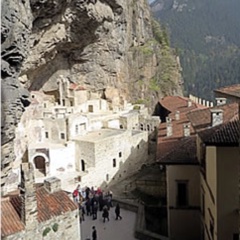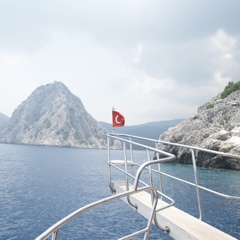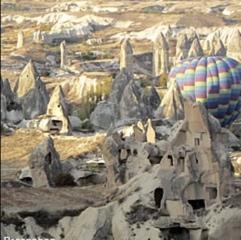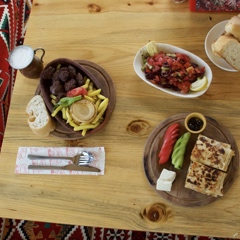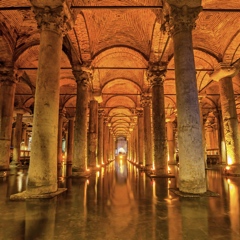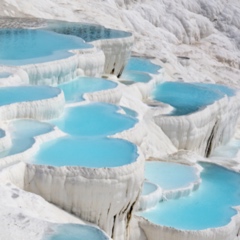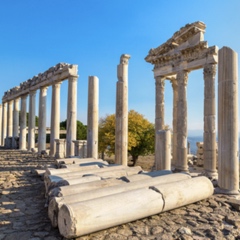Here’s an excerpt from my new travel memoir, Bright Sun, Strong Tea. (The previous episode is Rockefeller Geldi!)
While researching the second edition of my Lonely Planet guide in 1986, I made my third visit to Harran, the ancient town in southeastern Turkey mentioned in the Bible’s Book of Genesis. (The Patriarch Abraham stopped here for a few years on his journey to the Promised Land.)
I saw three girls in colorful traditional dress glancing at me, the unusual foreigner taking photographs of their strikingly photogenic beehive houses.
I looked their way, smiled, said Merhaba! and asked if I could take their picture.
“Evet!” (yes) they answered, and they lit up with smiles as though I had just offered them a one-month all-expense-paid luxury trip to Paris, wherever that might be. I squeezed off a few frames.
The oldest girl, probably in her late teens, looked very Turkish or Kurdish with her jet black hair, prominent black eyebrows and high cheekbones.
She was wearing a bright orange dress with multicolored floral patterns over blue-and-white polka dot shalvar (Turkish bloomers). She had on a plain white headscarf, a sleeved overwrap with shiny rick-rack trim, and an army-type canvas belt with one of those brass buckles where you slide the little rod sideways to cinch it. (I had a belt like that when I was a Cub Scout.) She had her left arm through the handle of a big woven split-reed basket.
The second girl had on a long blue dress, white headscarf, sleeved overwrap, a thick men’s leather belt riding low on her hips, and a large blue plastic basin in her left hand. Her hair was lighter, her features more Caucasian, and her smile even more brilliant than her friend’s.
The third girl, in a green dress with a pinky-red headscarf, was much younger, with blonde-tipped curls and a tiny infant in her arms. Even the infant was colorfully dressed in blue-and-yellow baby top and head covering.
They all had perfect teeth.
All together they were a concerto of colors and smiles too good to pass up. Their considerable delight at being photographed, at having this extraordinary little moment of unexpected and exotic pleasure interpellated into an otherwise routine, familiar day, came through in their simply brilliant smiles. The photo even caught the gleam in the second girl’s eyes.
Catching that moment and their pure innocent joy and pleasure is what photography is all about. I loved them and I still love that picture.
I submitted the photo along with hundreds of others when I sent in my manuscript in mid-1987, and the photo editor chose it for the book’s front cover. I thought it an excellent choice: eye-catching, colorful, exotic, it offered the allure of mystery and the ease of friendly welcome all at once.
When the book appeared early in 1988, the cover photo caused a furor.
Diplomatic Disapproval
Cut to the Turkish Embassy in Washington, DC. Today the embassy is in a modern building on a major avenue, but in 1988 it was in a sumptuous Embassy Row mansion finished in 1914 for Edward H. Everett of Cleveland, promoter of the crimped metal bottlecap with cork insert and owner of a fortune derived therefrom. Everett must have been fascinated by “oriental” (that is, Middle Eastern) culture because several rooms are decorated alla Turca, which makes the mansion a happily appropriate choice for a Turkish diplomatic mission, which it became in 1932 a few years after Everett’s death.
Pass through the metal detector, show your photo ID, get frisked by the security guards, approach the grand staircase but instead of climbing it turn to the right and knock on the big, dark solid wood door before you. An electronic latch buzzes and you enter the huge wood-panelled chamber decorated in classical style which was, in 1988, the office of His Excellency Dr Sükrü Elekdag, Ambassador of the Turkish Republic to the United States of America.
As you enter, Dr Elekdag, a tall, handsome man with jet black hair and craggy features, rises from his desk and, when he has confirmed visually the identity of his visitor, comes out from behind it to greet you. I feel pretty sure that there is a loaded pistol ready to hand in the desk, and that the desk itself may be bullet- and bomb-proof, which is why Dr Elekdag stays near it until he knows for sure who you are. (He has already been alerted by Security about your visit, which is by appointment in any case.)
On the landing halfway up the grand staircase is a memorial plaque to several dozen Turkish diplomats, their spouses, children, staff and clueless bystanders assassinated by Armenian terrorists during the 1970s and ’80s. Dr Elekdag is merely taking prudent precautions for someone in his position at this time.
For a number of years during the 1980s I worked as a consultant in public relations for Dr Elekdag. On most visits to his office, we discussed ways to educate Americans about the Turkish Republic, its history, culture and people, like informing them that the sultan was long gone and Turks weren’t Arabs. Most Americans hadn’t had a data refresh in nearly a century.
This visit, however, was different. Dr Elekdag wanted to discuss the cover photo on my recently published Lonely Planet guide. He was, as always, reserved, polite and formal, but obviously displeased with the choice. Probably ‘furious’ would be a more accurate way to phrase it, but he was far too well-mannered, gentlemanly and, well, diplomatic to expose me to unvarnished wrath.
“These village girls do not project an accurate picture of our country,” is all he said.
He was not the only one to think this way. Bookshop owners in Istanbul were refusing to stock or sell the book because of what they called “those gypsies” on the cover. My Turkish friends were all, 100%, upset at the choice. Turkey had struggled so mightily over more than half a century to modernize, secularize and democratize. It was on its way to becoming the economic powerhouse of the eastern Mediterranean, and now the best-selling guidebook to the country comes out bearing a photo of country bumpkins. The picture, they thought, sent exactly the wrong message: Turkey is poor and backward.
I understood why they disapproved, but suggested they look at it as a tourist might: unfamiliar with Turkey, the prospective visitor would see color, tradition, innocence, happiness, and a transparently heartfelt welcome. The photo was perfectly suited for its task of enticing people to buy the book and to visit Turkey. Besides, visitors would see the ‘real’ Turkey once they arrived, and would realize that the Harran girls were only one small aspect of it.
That’s how Lonely Planet and I learned why most guidebook covers are relatively boring photos of famous and easily identifiable buildings: these types of photos can’t blow up on you.
For later editions I and other LP authors were shown the cover photo choice and asked to comment on it. For the cover of the fourth edition, the photo editors had chosen a close-up of a section of colorful Turkish carpet. I thought it an excellent choice, and told them so.
“Can it blow up on us in any way?” they asked. “Could this carpet design be some traditional pattern, say a Kurdish or Armenian or Iranian or Chechen one, which could somehow have political overtones? Do the motifs have secret meanings?”
No, it was fine. Everyone thought it was great. It delighted a lot of travelers and sold a lot of books.
Even so, the photo of the girls in Harran is still one of my fondest visions of the friendliness one encounters so easily and so often in Turkey.
Click here to order an autographed copy of the book online with credit card or PayPal.
(Excerpts from Turkey: Bright Sun, Strong Tea copyright © 2004 by Tom Brosnahan. All rights reserved.)
(Next: What’s In A Name?)
| More Excerpts from Bright Sun, Strong Tea |  |



